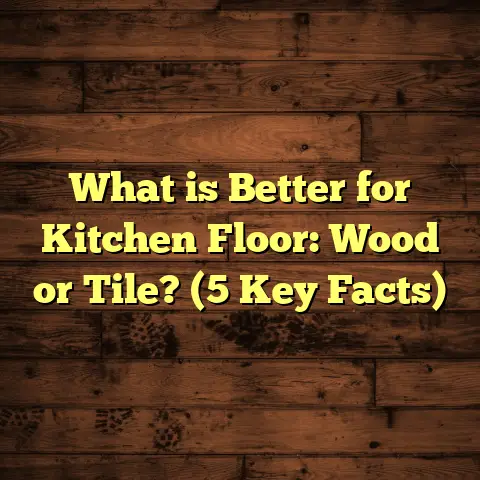What is Cork Flooring? (5 Benefits You Need to Know)
Finding the perfect flooring that combines comfort, durability, and style can be tricky. But after years of working with different materials, I discovered cork flooring, and honestly, it’s been a game changer in many projects I’ve tackled. If you’re curious about cork and why it’s gaining so much attention, let me share what I’ve learned firsthand.
What is Cork Flooring?
Cork flooring is a natural, eco-friendly flooring option made from the bark of the cork oak tree (Quercus suber). What’s fascinating is that this bark regenerates every 9-12 years without harming the tree itself, making cork a renewable resource. The harvesting process involves stripping the outer bark carefully by hand, allowing the tree to continue growing.
Once harvested, the cork bark undergoes several processing steps before becoming flooring:
- Boiling: The bark planks are boiled to soften them and remove impurities.
- Grinding: The softened cork is ground into granules.
- Binding: These granules are mixed with natural or synthetic resins to create sheets or tiles.
- Pressing: The mixture is compressed under heat to form dense sheets.
- Finishing: Sheets are cut into planks or tiles and finished with sealants or coatings to improve durability and appearance.
The result is a resilient, cushioned flooring material that offers unique properties you won’t find in traditional wood or tile floors.
Technically speaking, cork has a cellular structure made up of millions of tiny air-filled cells. This structure gives cork its elasticity, insulation properties, and ability to absorb sound and impact. The density of cork flooring typically ranges from 120 to 240 kg/m³, depending on the product type and manufacturing method.
When I first got into installing cork floors, I was amazed at how lightweight yet sturdy they felt underfoot. They have this natural springiness that’s comfortable to walk on for long periods — a huge bonus if you spend a lot of time standing or moving around your home.
Technical Specs Snapshot:
| Property | Typical Value |
|---|---|
| Density | 120 – 240 kg/m³ |
| Thermal Conductivity | 0.04 W/m·K (excellent insulator) |
| Sound Absorption | Up to 40 dB reduction |
| Compression Resistance | 0.5 – 1.5 MPa |
| Thickness Range | 3 mm to 12 mm |
So what’s the big deal about cork flooring? Here are five benefits I keep highlighting whenever someone asks about it.
1. Comfort & Warmth Underfoot
Have you ever noticed how cold and hard some floors feel during winter mornings? Cork solves that problem beautifully.
Thanks to its air-filled cellular makeup, cork acts like a natural cushion. Walking barefoot feels soft but supportive. This makes it especially great for kitchens, living rooms, or bedrooms—anywhere you want that cozy vibe.
Plus, cork has excellent insulation properties. Its thermal conductivity is about 0.04 W/m·K, which means it keeps your floors warm in winter and cool in summer. I’ve installed cork in homes located in colder climates, and clients often tell me their feet feel warmer compared to tile or hardwood alternatives.
One family I worked with in Vermont even said their energy bills dropped slightly because their cork floors helped retain heat better.
The softness of cork also reduces fatigue if you stand on it for long periods—something I’ve noticed myself when installing it in kitchens or workspaces where people stand a lot.
How Does Cork Provide Comfort?
Cork’s microscopic air pockets compress under pressure and then spring back to their original shape. This elasticity reduces strain on your feet, legs, and back. Unlike tile or concrete that can be unforgiving on joints, cork absorbs shocks naturally.
I remember working on a home renovation where the client had chronic back pain. After installing cork flooring in their home office and kitchen—places they spent most time standing—they reported noticeably less discomfort after a few weeks. That personal feedback stuck with me; it’s one thing to talk about comfort but seeing it help someone physically was powerful.
Additionally, cork flooring’s warmth isn’t just about temperature; it also creates a psychological sense of coziness. That’s why many people prefer carpeted rooms for comfort—cork offers a similar feel without the dust and maintenance drawbacks.
2. Eco-Friendly and Sustainable
If sustainability matters to you (and it should!), cork flooring fits right in with a green lifestyle.
Because cork is harvested without cutting down trees and regenerates naturally, it’s one of the most renewable flooring materials out there. The cork oak forests also play an important environmental role by supporting biodiversity and preventing desertification.
From my experience sourcing materials for eco-conscious clients, cork often outperforms engineered hardwood or vinyl on environmental impact assessments. There are certifications like FSC (Forest Stewardship Council) for cork products that guarantee responsible harvesting practices.
Also, cork manufacturing uses less energy compared to synthetic flooring production methods, so the carbon footprint tends to be lower overall.
How Sustainable is Cork?
Cork oak trees are primarily grown in Mediterranean regions like Portugal, Spain, and parts of North Africa. These forests cover roughly 2.3 million hectares worldwide and act as carbon sinks—absorbing significant amounts of CO₂ every year.
Harvesting cork bark encourages tree survival because it increases longevity—trees live for up to 200 years! By comparison, hardwood trees used for flooring are usually cut down entirely.
I’ve visited a cork forest in Portugal during one project trip and was struck by how well-managed these forests are. They’re harvested every decade by skilled workers who remove only the outer bark without damaging inner layers. This sustainable cycle means cork can be produced indefinitely without deforestation risk.
Environmental Benefits Summary:
- Regrowth: Bark regenerates every 9-12 years.
- Carbon Sequestration: Cork forests absorb millions of tons of CO₂.
- Biodiversity: Forests support wildlife habitats.
- Low Waste: Manufacturing produces minimal scrap; leftovers often recycled.
- Biodegradable: Cork floorings break down naturally at end-of-life.
My clients who prioritize green building materials love this aspect of cork. It aligns with LEED certification goals and other green building programs easily.
3. Durability Meets Easy Maintenance
You might wonder if such a soft and natural material can hold up to daily wear and tear. Spoiler: it can—and quite well!
Cork flooring is surprisingly durable due to the resin binders added during manufacturing and the protective finishes applied afterward. These finishes can resist scratches, dents, and stains pretty effectively when maintained properly.
In my projects, I recommend applying a polyurethane or acrylic sealant layer. This makes cleanup simple—usually just sweeping and occasional damp mopping.
A study I reviewed revealed that high-quality cork floors can last 20-30 years with good care. That’s comparable to many hardwood floors but with less chance of cracking or warping since cork expands and contracts less with humidity changes.
I installed cork in a busy daycare center where kids ran around all day—after three years, it still looked fantastic with only minor scuffs easily buffed out.
How Durable Is Cork Flooring?
While cork is softer than hardwood or tile on the Mohs hardness scale (usually around 2-3), its structure allows it to bounce back from minor surface damage rather than cracking outright.
The secret lies in the finishes applied after manufacturing:
- Polyurethane Sealants form a protective transparent layer resistant to scratches and spills.
- UV-Cured Coatings increase hardness without yellowing over time.
- Wax Finishes provide natural sheen but require more frequent reapplication.
In commercial settings where traffic is heavy, I always push for multiple sealing layers during installation for longevity.
Tips for Maintaining Cork Floors
- Sweep regularly to avoid grit buildup which can scratch surfaces.
- Use damp mop occasionally with pH-neutral cleaners designed for cork.
- Avoid excessive water pooling as moisture can damage underlying glue or subfloor.
- Place felt pads under furniture legs to prevent indentations.
- Reapply sealant every few years depending on wear level.
One homeowner I worked with had pets who often scratched floors. By following these care tips, they kept their cork looking great beyond five years without replacing planks.
4. Sound Absorption & Noise Reduction
Ever had a situation where footsteps echo loudly through your home? Cork flooring is excellent at reducing noise both inside rooms and between floors.
Those tiny air pockets inside cork act as natural sound barriers. According to testing data, cork can reduce impact noise by up to 40 decibels—a noticeable difference for anyone living in apartments or multi-story houses.
I remember installing cork in an apartment complex where tenants complained about noise complaints from neighbors below. After switching to cork flooring, they reported much quieter living spaces with fewer disturbances.
This property also makes cork popular in offices, libraries, or music rooms where quiet environments are essential.
How Does Cork Reduce Noise?
Sound travels as vibrations through solid materials like wood or tile floors. Cork’s cellular structure disrupts these vibrations by absorbing energy within its air pockets rather than transmitting them onward.
In technical terms:
- Impact Insulation Class (IIC): Measures sound reduction from impact noises like footsteps.
- Cork floors combined with underlayments typically achieve an IIC rating between 50 and 65.
- This level can reduce loud footfalls to soft thuds that barely disturb people below or adjacent rooms.
In multi-story buildings where noise complaints are common, this benefit alone makes cork worth considering.
Real-Life Experience
In one commercial project for a music studio, we layered thick cork flooring over acoustic mats to create an ideal sound environment. Musicians appreciated how much quieter the studio felt even when drums were played loudly upstairs—without disturbing neighbors or other studios nearby.
The difference was so clear that they requested the same setup for practice rooms across their facility.
5. Hypoallergenic & Health Benefits
If allergies or asthma concern you, cork flooring might be a perfect choice.
Unlike carpet that traps dust mites and allergens, cork’s tight surface minimizes dust accumulation while being easy to clean. Plus, cork naturally resists mold and mildew because it doesn’t retain moisture easily.
In addition, cork contains suberin—a natural waxy substance that repels water and acts as an antimicrobial agent.
I once installed cork for a client who suffered from severe allergies; they noticed fewer symptoms after switching from carpeted rooms. This made me appreciate how this flooring can contribute positively to indoor air quality and overall health.
Why Is Cork Hypoallergenic?
Allergens like dust mites thrive in porous materials such as carpets. Cork’s dense surface reduces these hiding spots significantly:
- It doesn’t trap pet dander or pollen.
- It resists mold growth even in humid areas.
- It has natural anti-fungal properties thanks to suberin content.
- Easy cleaning prevents buildup of irritants over time.
Many doctors recommend non-carpeted floors for allergy sufferers; cork offers an appealing alternative that still feels warm and soft compared to tile or hardwood.
Diving Deeper Into Manufacturing: How Cork Flooring Comes Alive
Since I’m passionate about understanding materials from the ground up (literally), let me walk you through the production journey of cork flooring in more detail.
Step 1: Harvesting the Bark
Workers strip the bark from mature cork oak trees by hand using specialized axes called corta-mato. This careful approach ensures only outer bark is removed without damaging inner layers—key for tree health and future harvests.
Trees must be at least 25 years old before their first harvest; subsequent harvests occur every 9–12 years depending on climate conditions.
Step 2: Boiling & Drying
The harvested bark planks are boiled in water for about one hour at nearly 100°C (212°F). This softens them significantly while removing tannins and other substances that could affect quality or color consistency later on.
After boiling, planks dry for several weeks outdoors before further processing begins.
Step 3: Granulation & Agglomeration
Dried bark is ground into granules of varying sizes depending on final product type:
- For solid cork tiles, larger granules are preferred.
- For engineered planks, finer granules mix better with binders.
These granules are then mixed with resin binders—either natural latex or synthetic adhesives—and pressed under high pressure (<del>10 MPa) at elevated temperatures (</del>150°C) into large sheets or blocks called agglomerates.
Agglomerates form the base material for most commercial cork floors today due to improved stability over solid blocks alone.
Step 4: Cutting & Finishing
Agglomerate blocks are sliced into planks or tiles of specific thicknesses (commonly between 3 mm – 12 mm).
These pieces receive surface treatments for protection:
- Polyurethane coatings enhance scratch resistance.
- UV-cured finishes improve durability without yellowing.
- Some manufacturers add decorative layers printed with wood grain or stone patterns for aesthetics while retaining cork’s natural benefits underneath.
Finally, planks are packaged ready for shipping worldwide.
Myths About Cork Flooring—Busted!
I’ve heard plenty of misconceptions about cork flooring over my career—let’s clear up some common ones:
Myth #1: Cork Floors Are Fragile
Truth: While softer than hardwood on a hardness scale, quality cork floors sealed properly resist scratches well enough for most households—even those with pets or kids.
Myth #2: Cork Is Expensive
Truth: Pricing varies widely depending on thickness, finish, and brand but generally falls between $5-$12 per square foot including installation—competitive with many hardwood options.
Myth #3: Cork Isn’t Waterproof
Truth: While not fully waterproof like vinyl or tile, sealed cork resists moisture well enough for kitchens and bathrooms if spills are cleaned promptly. Avoid standing water though!
Myth #4: Cork Is Difficult to Maintain
Truth: Simple sweeping plus occasional damp mopping keeps cork floors looking fresh without special cleaners or waxing routines common in other materials.
Comparing Cork To Other Flooring Options
If you’re wondering how cork stacks up against alternatives like hardwood, laminate, vinyl, or tile—here’s my take based on both data and real-world experience:
| Feature | Cork | Hardwood | Laminate | Vinyl | Tile |
|---|---|---|---|---|---|
| Comfort | High (soft & warm) | Moderate | Low | Low | Low |
| Durability | Moderate-High | High | Moderate | Moderate | Very High |
| Maintenance | Easy | Moderate | Easy | Easy | Moderate |
| Eco-Friendliness | Very High | Moderate | Low | Low | Low |
| Sound Absorption | High | Moderate | Low | Low | Low |
| Cost (material+install) | $5-$12/sq ft | $8-$15/sq ft | $3-$7/sq ft | $2-$6/sq ft | $5-$15/sq ft |
| Water Resistance | Moderate | Low | Low | High | Very High |
From what I’ve observed installing all these types:
- Cork is unbeatable if you want comfort plus eco-friendly features without sacrificing durability too much.
- Hardwood offers timeless beauty but can be cold and hard underfoot.
- Laminate is budget-friendly but lacks warmth or sound absorption.
- Vinyl wins on water resistance but feels synthetic.
- Tile lasts forever but can be harsh on feet and noisy indoors.
Installation Insights From My Projects
Installing cork flooring is usually straightforward but requires attention to detail:
Subfloor Preparation
Whether concrete slab or wooden underlayment—the floor must be level within ±3mm per meter to avoid issues later. Moisture barriers or vapor retarders are critical over concrete slabs since excess moisture damages glue-down installations.
Installation Methods
Floating Floor: Most popular among DIYers because planks click together over an underlayment without glue or nails making removal easier if needed later.
Glue-down: Adhesive applied directly to subfloor giving better stability but requires professional skill/time investment.
Nail-down: Rarely used except solid block cork installed over wood subfloor; nails secure planks firmly but restrict movement tolerance leading to cracking if not done precisely.
From personal experience installing floating floors for residential jobs saves time (~1 day per 500 sq ft), while glue-down suits commercial use better due to traffic demands.
Expansion Gaps & Finishing Touches
Like wood floors, leave small gaps (~8mm) around perimeter walls to allow expansion/contraction due to humidity changes preventing buckling problems during seasons shifts.
Baseboards cover these gaps neatly while adding room character visually as well.
Addressing Concerns About Cork Flooring
Sometimes people bring up worries when considering cork—here’s my take on common ones I’ve encountered:
Will It Fade In Sunlight?
Direct sunlight over prolonged periods can cause slight fading but quality UV-cured finishes protect most surfaces well enough indoors unless exposed all day long through large windows without curtains/blinds.
What About Scratches From Heavy Furniture?
Placing felt pads under legs helps significantly; heavier furniture will leave indentations if dragged repeatedly but not permanent gouges if sealed properly.
Can It Be Used In Bathrooms?
Yes—but only if sealed excellently against moisture ingress combined with good ventilation because standing water damages glue adhesives underneath over time causing planks to lift/warp eventually.
How To Choose The Right Cork Flooring For Your Home
Not all cork floors are created equal; here’s what I suggest looking out for when shopping:
Thickness Matters
Thicker planks (8–12 mm) offer better durability & insulation but cost more; thinner ones (3–6 mm) suit light-use areas or overlays on existing floors cheaper yet may wear faster long term.
Surface Finish Types
Matte finishes hide scratches better while gloss looks sleek but shows wear more noticeably over time. Some finishes also add slip resistance—a good idea if you have kids or elderly family members around.
Pattern & Color Options
Cork comes naturally tan-brown but manufacturers add stains/dyes creating lighter greys or darker hues fitting various décor styles from rustic farmhouse to modern minimalist effortlessly.
Certifications & Warranties
Look for FSC certification guaranteeing sustainable sourcing plus warranties covering wear/damage at least five years as indicators of product quality/trustworthiness.
A Closer Look At Costs: What To Expect Budget-wise
Pricing depends heavily on quality grade, thickness, finish type plus labor rates regionally:
| Cost Aspect | Range (USD/sq ft) |
|---|---|
| Material (Basic) | $3 – $6 |
| Premium Material | $6 – $10 |
| Installation Labor | $2 – $5 |
| Underlayment | $0.50 – $1 |
| Finishing/Sealing | $1 – $2 |
For an average home needing around 1,000 sq ft covered with mid-range cork including installation expect roughly $7,000 – $12,000 total investment depending on location and customization level chosen.
Over time this pays off through energy savings (due to insulation) plus lower maintenance costs compared to carpet replacements every few years or refinishing hardwood floors frequently.
Final Thoughts From My Experience
Working extensively with different flooring options has taught me that no single material fits every need perfectly—but few come close like cork does when balancing comfort, environmental responsibility, and practicality together seamlessly.
Whether upgrading your kitchen floor, designing a cozy living space, or outfitting commercial areas needing sound control, cork offers benefits worth considering seriously.
I’ve seen its positive effects firsthand—from reducing clients’ allergy symptoms, lowering energy bills, to creating inviting spaces where families love spending time.
If you want more advice about choosing, installing, or caring for your new cork floor, just reach out—I’m happy to share tips that make your project easier.
Would you like me to provide specific product recommendations based on your region? Or details about installation tools? I’m here whenever you want!





